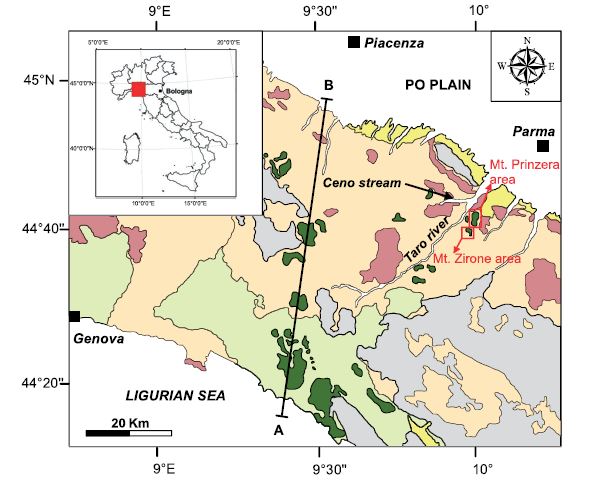A conceptual hydrogeological model of ophiolitic aquifers (serpentinised peridotite): The test example of Mt. Prinzera (Northern Italy)
The main aim of this study is the experimental analysis of the hydrogeological behaviour of the Mt. Prinzera ultramafic massif in the northern Apennines, Italy
Abstract
The main aim of this study is the experimental analysis of the hydrogeological behaviour of the Mt. Prinzera ultramafic massif in the northern Apennines, Italy. The analysed multidisciplinary database has been acquired through (a) geologic and structural survey; (b) geomorphologic survey; (c) hydrogeological monitoring; (d) physico The ultramafic medium is made of several lithological units, tectonically overlapped. Between them, a low and causes a perched groundwater to temporary flow within the upper medium, close to the surface.
This perched groundwater flows out along several structurally controlled depressions, and then several high perennial basal (i.e., low altitude) springs, caused by the compartmentalisation of the system because of high ‐chemical analyses; and (e) isotopic analyses.‐permeability, discontinuous unit has been identified. This unit behaves as an aquitard‐altitude temporary springs can be observed during recharge, together with several‐angle tectonic discontinuities.
Introduction
The ophiolite bodies of the Alpine and Apennine belts are mostly composed of peridotites, serpentinites, gabbros, and basalts representing the original oceanic crust of the Ligure basin, developed in the Middle to Upper Jurassic, which separated the Europe plate from the Adria plate (Marroni et al., 2010). In the northern Apennines, these remnants of oceanic lithosphere are found within the Ligurian tectonic units and crop out in two palaeogeographic domains (Figure 1): the internal ligurides and external ligurides, which are identified on the basis of their current structural characteristics and their relationships with the associated sedimentary sequences (Abbate et al., 1986; Bortolotti et al., 2001; Elter, 1972; Elter, 1993).
The ophiolites are retained as one of the main aquifers within the northern Apennines (Gargini et al., 2014), but a few hydrogeological studies have been carried out worldwide to understand the behaviour of such aquifers (e.g., Boronina et al., 2003; Boronina et al., 2005; Dewandel et al., 2003; Dewandel et al., 2004; Dewandel et al., 2005; Join et al., 2005; Nikic et al., 2013).
In this framework, an experimental study has been carried out in the test site of Mt. Prinzera ultramafic massif (Lat. 44°38 and robust conceptual model, merging information from field geological, geomorphological, hydrogeological, hydrochemical, and isotopic analyses. This conceptual model has been then compared to those defined in other countries, in order to emphasise and discuss the main similarities and differences.
Geological, structural, and geomorphological data

A detailed mapping survey was carried out in order to define and analyse those features that may control the hydrogeologic behaviour of the system, with emphasis on both the lithologic and the tectonic discontinuities. The fracture parameters inferred to influence groundwater flow (Singhal & Gupta, 1999; Bense et al., 2013) were quantitatively evaluated by collecting the following discrete structural data: (a) secondary fault number of fracture sets, (c) persistence, (d) aperture, and (e) spatial distribution.

These fracture attributes were measured along a 73 mlong scan line intercepting at least three water lineaments. Such structures, identified in the geological mapping as major normal fault systems, host one of the monitored seasonal springs.
Stefano Segadelli, Paolo Vescovi, Kei Ogata, Alessandro Chelli, Andrea Zanini, Tiziano Boschetti, Emma Petrella, Lorenzo Toscani, Alessandro Gargini, Fulvio Celico, Hydrological Processes, jan 2016
Authors
Stefano Segadelli, Paolo Vescovi, Kei Ogata1, Alessandro Chelli, Tiziano Boschetti, Emma Petrella, Lorenzo Toscani, Fulvio Celico - Department of Physics and Earth Sciences Macedonio Melloni”, University of Parma, Parco Area delle Scienze, 157/A, Parma 43124, Italy
Andrea Zanini - Department of Civil, Environmental, Land
Alessandro Gargini - Department of Biological, Geological, and Environmental Sciences, Alma Mater Studiorum University of Bologna, via Zamboni, 33, Bologna, 40126, Italy
